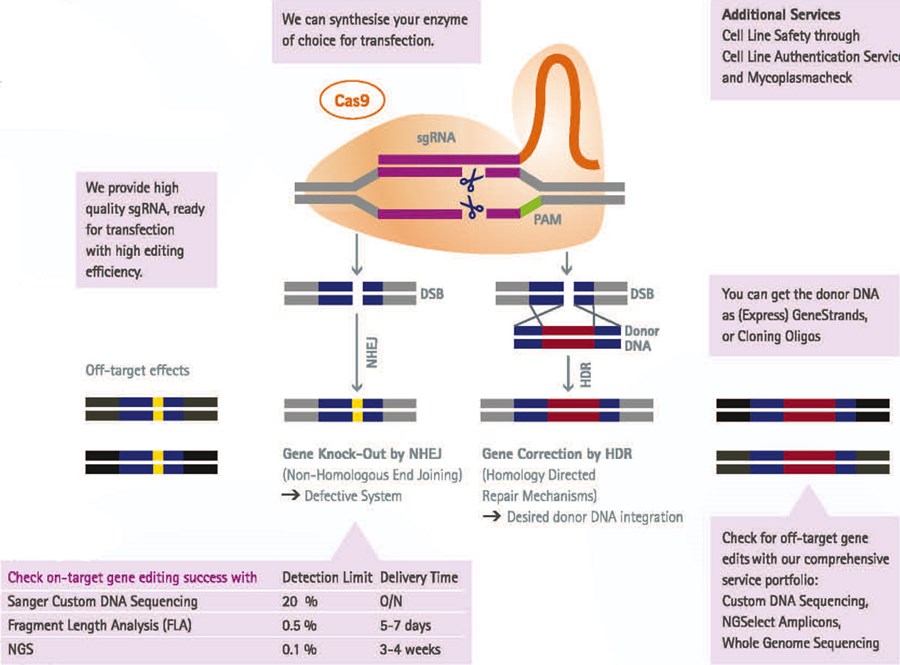The CRISPR/Cas9 system is one of the latest developments in the field of genetic engineering. CRISPR technology makes it possible to perform easy and cost efficient editing of a cells´ genome - as demonstrated in every organism studied so far!
Eurofins Genomics offers a comprehensive product portfolio to guide your CRISPR/Cas9 experiment to success.
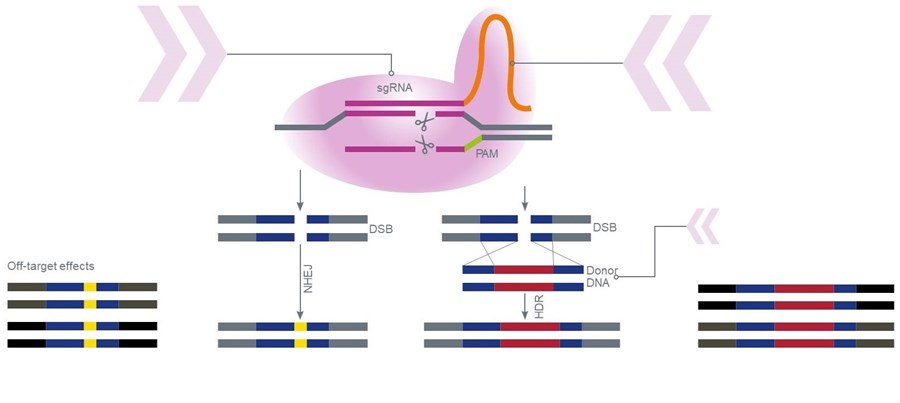
EXTREmer Oligos
Create the target-specific region of your gRNA by the simple annealing of two complementary EXTREmer Oligos. Also, you can anneal EXTREmer oligos for dsDNA and cloning applications. More Info.
Order EXTREmer Tubes l Order EXTREmer Plates
GeneStrands DNA Fragments
Do you prefer transfection with RNA? We can synthesize your dsDNA Gene Fragment as a 'promoter:gRNA:terminator' construct for in vitro transcription. Also, you can transcribe gRNA for direct transfection. More Info.
Order GeneStrand Fragments
Sanger Sequencing
Use our TIDE protocol to check the sequence of your CRISPR plasmid or genomic target sequence. More Info.
Submit Tube Sequencing l Submit Plate Sequencing l Order Seq Kit
Gene Synthesis
Do you need larger dsDNA constructs? We can synthesise whole chimeric gRNAs, donor DNAs or optimised Cas9 enzymes. More Info.
Order Genes
Next Generation Sequencing
Make sure that the target modification is introduced or identify off-target effects of your CRISPR System by genome sequencing.
The "Protocol" tab explains in detail how to design your CRISPR/Cas9 experiment with our products.
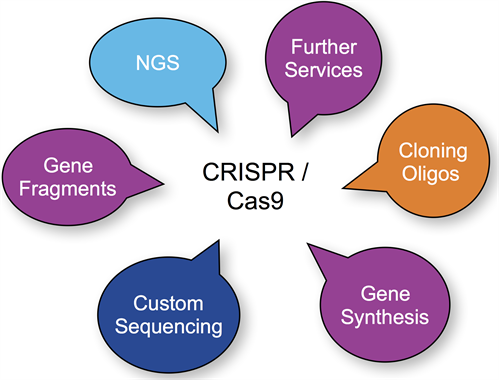
Three essential elements of a CRISPR system are: the design of a gRNA, the transfection method and sequencing to verify the system.
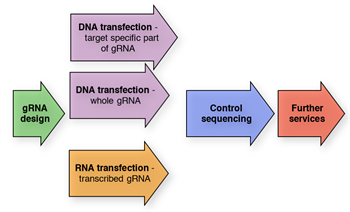
An overview of how you can develop your CRISPR experiment with our products:
In the Background tab we explain how gene editing with CRISPR works.
- Design of gRNA
- Copy the sequence you want to modify in one of the freely available CRISPR online tools. The software searches for a PAM motif within your target gene and on the basis of other criteria an appropriate gRNA is designed. Now you decide how to transfect the cells of your choice: For transfection with DNA you require either the sequence-specific part of the gRNA, or the complete chimeric gRNA, depending on the vector construct you choose. Alternatively transfect your cells with in vitro transcribed RNA.
- A - Transfection with DNA: specific part of the gRNA
- Choose a CRISPR plasmid from the offering of your favorite plasmid supplier. Example: On your plasmid the constant region of gRNA is already coded. Therefore, you only need the target specific part of the chimeric gRNA. Basic-Service Paste your previously designed gRNA on our Cloning Oligo order page and expand the sequence with restriction sites required for cloning. In addition, order the complementary reverse sequence. After receiving your order, simply anneal the two oligos and clone the double-stranded DNA in your CRISPR vector. + Premium-Service: We anneal your gRNA oligos and clone them into the vector of your choice. Please contact our Subcloning-Team.
- B - Transfection with DNA: whole gRNA
- Choose a CRISPR plasmid or empty plasmid backbone from the offering of your favorite plasmid supplier. Example: The constant region of gRNA is not coded on your choosen plasmid. Therefore, you need the target specific part of the gRNA as well as the constant region, both on a continuous DNA construct. Basic-Service Paste the previously designed sequence specific region of the gRNA on our Gene Synthesis order page and copy the sequence of gRNAs constant region at the end (deposited here). In the next order step you select restriction overhangs for cloning into your CRISPR vector. + Premium-Service: We clone your chimeric gRNA into any vector of your choice as ready-to-transfect construct. Please contact our Subcloning-Team.
- C - Transfection with RNA: in-vitro transcribed gRNA
- Example: Your cells should be transfected with in-vitro transcribed RNA. Therefore you need the target specific part and the constant region of gRNA, together with a promoter and a terminator sequence on a continuous DNA construct. Basic-Service Paste the promoter sequence of your choice in our Gene Fragments order form. After this sequence, copy the previously designed target specific region of the gRNA and the sequence of the gRNAs constant part (deposited here). Finally enter the terminator sequence. We will synthesise the sequence as a linear dsDNA Gene Fragment, so you can easily create your ready-to-transfect gRNA by in vitro transcription. + Premium-Service: We will send the gRNA already transcribed into RNA. Please contact our experts for long RNA.
- Control sequencing
- Check your CRISPR construct with our Custom Sequencing service by Sanger Sequencing. Make sure that your desired modification has been introduced, or identify potential off-target effects by Next Generation Sequencing. Please contact our NGS experts.
- Further services
- In addition, we are happy to assist you with further requests concerning your CRISPR experiment. These include: Gene Synthesis of donor DNA for Knock-In experiments or synthesis of a CRISPR plasmid tailored to your requirements Codon optimisation or other enhancements of your Cas9 enzyme Side-directed mutagenesis for precise modifications in your Cas9 enzyme Plasmid preparations at various scales
The CRISPR system is a naturally occurring mechanism in bacteria for defense against bacteriophages. In recent years the system has been made available for genetic engineering in order to introduce specific changes in a cells genome.
What is needed for CRISPR?
For a functional CRISPR system three components must be considered:
Genomic target sequence: Within the gene you want to change, a sequence motif "NGG" (PAM motif) must be present. Inside 20 bp upstream of this motif a double-strand break is introduced.
guide RNA: The gRNA consists of two structural parts which are connected to form a chimeric gRNA. The sequence-specific part of the gRNA is a RNA of 20 bp in length which is complementary to the genomic sequence. This part varies depending on the target sequence. The second part of the gRNA is constant, no matter which genomic sequence is targeted.
Cas9 enzyme: The Cas9 protein is an RNA guided endonuclease. Once the enzyme has the gRNA bound it is directed to the genomic target sequence. Within the target sequence Cas9 introduces a double-strand break.
How does CRISPR work?
Once the three components are present in the cell, the CRISPR system is active: Cas9 binds the transcribed gRNA. The gRNA guides the Cas9 enzyme to the genomic sequence which is complementary to the sequence-specific part of the gRNA. Once Cas9 arrives at the target-sequence the endonuclease becomes active and introduces a double-strand break into the cells genome.
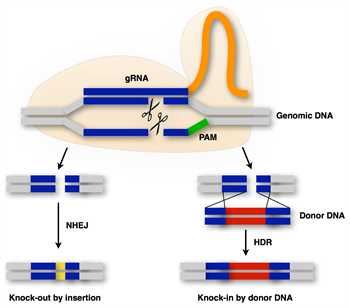
The repair of the double-strand can be performed in two ways:
Knock-Out by NHEJ: The two separate DNA sequences can be recombined by non-homologous end joining, but this mechanism is defective. For example, incorporation of 1 additional basepair into the target sequence results in a frame shift and ultimately an inactive protein.
Knock-In by HDR: Providing the cell with a donor DNA, homologous to the sequences up- and downstream of the target region, the double-strand break may be repaired by the homology directed repair mechanism. In this case, the donor DNA integrates at the site of the double-strand break into the genomic sequence.
Applications for CRISPR
By introducing Knock-Outs or Knock-Ins, CRISPR is used for various applications of molecular biology, such as:
- Studying the gene function
- Introducing point mutations
- Exchanging of genes
- Adding or removing genes
- Modifying regulatory elements
